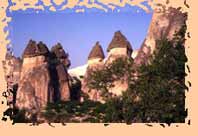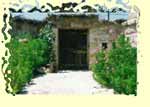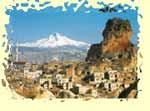KAYADAM
Hotel
Cappadocia - Turkey
Prehistoric Period
Traces of Prehistoric cultures in Cappadocia can most easily be found around Köskhöyük/Nigde, Asiklihöyük/Aksaray and in the Civelek cave near Nevsehir. Excavations in these three areas are still taking place.
Asikli Höyük (mound)
Archaeological excavations uncovered the first brick living quarters in Cappadocia in Asikli Höyük (mound), an extension of Aksaray's Ihlara Canyon settlements. Yellow and pink clay plaster was used in making the walls and floors of the houses, some of the most beautiful and complicated architectural examples of first towns. They buried the dead in the Hocker position, like a foetus in the womb, on the floor of their houses. According to Prof. U. Esin, who researched at Asikli Höyük, a bigger population than that that had been previously theorised was revealed by the abundance and density of the settlements discovered in these areas in the Aceramic Neolithic Period. Nowhere else in Anatolia can the unique obsidian tools be found like those from Cappadocian Tumuli. Figurines, made from lightly baked clay, were unearthed together with flat stone axes wrought in many fine shapes, chisels and coulters made from bones and ornaments made from copper, agate and other different kinds of stones. Evidence provided by a skeleton found here indicates that the earliest brain surgery (trepanation) known in the world was performed on a woman 20-25 years of age at Asikli Höyük.
Protohittite and Assyrian Trade Colonies Periods (3000BC - 1750BC)
Mining and metallurgy reached its peak in Anatolia during the Early Bronze Age. Major developments were observed in Northern Anatolia towards the end of this period. Between 2000BC and 1750BC Assyrian merchants from northern Mesopotamia formed the first commercial organisations by establishing trade colonies in Anatolia. The centre of these colonies was at Kanesh Kharum near Kültepe in Kayseri province (Kharum: A commercial market place). Another important commercial market place referred in documents is the Kharum Hattush at Bogazköy. Anatolia was rich in gold, silver and copper, but lacked tin, essential for obtaining bronze as an alloy. For this reason tin was one of the major trading materials, as well as textile goods and perfumes. The merchants had no political dominance, but were protected by the regional Beys.
Fortunately for the Assyrian merchants, writing was seen for the first time in Anatolia. From the "Cappadocia tablets", cuneiform clay tablets on which ancient Assyrian was written, it has been learnt that merchants paid a 10% road tax to the Bey, received 30% interest from locals for, and paid a 5% tax to the Anatolian kings for goods they sold. The same tablets tell us that Assyrian merchants sometimes married Anatolian women, and the marriage agreements contained clauses to protect the women's rights from their husbands.
Assyrian merchants also introduced cylinder seals, metallurgy, their religious beliefs, Gods and temples to Anatolia. Native Anatolian art flourished under the influence of Assyrian Mesopotamic art, eventually developing an identity of its own. During the following ages this developed into the fundamentals of Hittite art.
The Roman Period (17AD - 395AD)
The wars came to an end in 17AD when Tiberius conquered Cappadocia and placed it under Roman rule. After the conquest, the Romans reconstructed the road to the west that was of both commercial and military significance.
During the Roman era the area saw many migrations and attacks from the east. The area was defended by Roman military units known as "Legions".
During the reign of Emperor Septimus Severus, Cappadocia's economy flourished, but the capital, Kayseri (Caesera) was attacked by Sassanid armies from Iran. Emperor Gordianus III ordered the construction of defensive city walls.
During this time some of the first Christians were moving from the big cities to villages. In the 4th century, when Kayseri was a flourishing religious centre, the rocky landscape of Göreme was discovered. Adopting the teachings of St. Basil, Bishop of Caesarea (Kayseri), the Christians began to lead a monastic life in the carved out rocks of Cappadocia.
Hittite Period (1750-1200 BC)
People coming from Europe via the Caucasus, and settling in Cappadocia around 2000 BC, formed an Empire in the region merging with the native people of the area. Their language was of Indo-European origin.
The capital of the Hittite kingdom was at Hattushash (Bogazköy), and the other important cities were Alacahöyük and Alisar. Hittite remains can be found in all the tumuli in Cappadocia.
The Hittite Empire, which lasted for six centuries in the region, collapsed around 1200 BC when the confederacy of Hittite states was invaded by the Phrygian people from the Balkans.
The Byzantine Period (397 - 1071)
When the Roman Empire divided into two, Cappadocia fell under the eastern region. In the early 7th century there were severe wars between the Sassanid and Byzantine armies, and for 6 or 7 years the Sassanids held the area. In 638 Caliph Ömer ended the domination of the Sassanids, and the Arab Ommiades began to attack.
The long lasting religious debates among sects reached a peak with the adoption of the Iconoclastic view by Leon III, who was influenced by Islamic traditions. Christian priests and monks who were in favour of icons began to take refuge in Cappadocia. The Iconoclastic period lasted over a century (726-843). During this time, although several Cappadocian churches were under the influence of Iconoclasm, the people who were in favour of icons were able to continue to worship comfortably.
Late Hittite Kingdom (1200-700 BC)
After the Phrygians destroyed all the important towns in Central Anatolia eliminating the Hittite Empire, fragments of the Late Hittite Kingdoms sprang up around central and southeast Anatolia. The Late Hittite Kingdom in Cappadocia was the Tabal kingdom, which extended over Kayseri, Nevsehir and Nigde. Rock monuments from this age, with Hittite hieroglyphics can be found at Gülsehir.
The Seljuk Period (1071-1299)
The arrival of the Seljuk Turks in Anatolia marked the beginning of a new era in history. After their victories in Iran and Mesopotamia, Turks rapidly spread throughout Anatolia, settling there in the second half of the 11th century. In 1071 the Byzantine emperor Romanos Diogenes, who was of Cappadocian origin, was defeated and captured by the Seljuk ruler Alparslan at Malazgirt. In 1080 Suleiman Shah founded the Anatolian Seljuk State, the capital of which was Konya. In 1082 Kayseri was conquered by Turks. Cities such as Nigde and Aksaray were reconstructed, and caravanserais, mosques, Madrasah, and tombs were built.
The Seljuk Turks' conquest of Anatolia did not affect the administrative authority of the Patriarchy. It was only after the 14th century that its size and status were diminished.
The Persian Empire and The Kingdom of Cappadocia (585BC-332BC)
The Cimmerians ended the Phrygian reign, and were then followed by the Medes (585BC) and the Persians (547 BC). The Persians divided the empire into semi autonomous provinces and ruled the area using governors who were known as 'satraps'. In the ancient Persian language, Katpatuka, the word for Cappadocia, meant "Land of the well bred horses".
The Persians gave their people the freedom to choose their own religion and to speak their native languages. Since the religion they were devoted to was the Zoroastrian religion, fire was considered to be divine, and so, the volcanoes of Erciyes and Hasandagi were sacred for them. The Persians constructed a "Royal Road" connecting their capital city in Cappadocia to the Aegean region. The Macedonian King Alexander defeated Persian armies twice, in 334 and 332 BC, and conquered this great empire.
After bringing the Persian Empire to an end, King Alexander met with great resistance in Cappadocia. He tried to rule the area through one of his commanders named Sabictus, but the ruling classes and people resisted and declared Ariarthes, a Persian aristocrat, as king. Ariarthes I (332 - 322 BC) was a successful ruler, and extended the borders of the Cappadocian Kingdom as far as the Black Sea.
The kingdom of Cappadocia lived in peace until the death of Alexander. From then until 17AD, when it became a Roman province, it fought wars with the Macedonians, the Galatians and the Pontus nation.
The Ottoman Period
The Region of Cappadocia was very peaceful also during the Ottoman Period. Nevsehir was a small village in the province of Nigde until the time of Damat Ibrahim Pasha. At the beginning of the 18th century, especially during the time of Damat Ibrahim Pasha, places like Nevsehir, Gülsehir, Ozkonak, Avanos and Ürgüp prospered and mosques, külliyes (a collection of buildings of an institution, usually composed of schools, a mosque, lunatic asylum, hospital, kitchen, etc.) and fountains were built. The bridge in the centre of the town of Ozkonak, which was built during Yavuz Sultan Selim's campaign to the east (1514), is important in terms of being an early Ottoman Period building.
The Christian people living in the area were treated with tolerance in the Ottoman Period as in the Seljuk Period. The 18th century church of Constantine-Helena in Sinasos-Ürgüp, the 19th century church built in honor of Dimitrius in Gülsehir and the Orthodox Church in Derinkuyu are some of the best examples of this tolerance.
(CappadociaOnline)
Strabon, a writer of antiquity, describes the borders of the Cappadocia Region, in his 17-volume book Geographika (Geography) written in his maturity in Rome during the reign of Emperor Augustus, as a very large area surrounded by Taurus Mountains in the south, Aksaray in the west, Malatya in the east and all the way up to the Black Sea coast in the north. Present day Cappadocia is the area covered by the city provinces of Nevsehir, Aksaray, Nigde, Kayseri and Kirsehir. The smaller rocky region of Cappadocia is the area around Uchisar, Goreme, Avanos, Urgup, Derinkuyu, Kaymakli and Ihlara.
Formation of Fairy Chimneys
The interesting rock formations, known as "fairy chimneys", have been formed as the result of the erosion of this tufa layer, sculpted by wind and flood water, running down on the slopes of the valleys. Water has found its way through the valleys creating cracks and ruptures in the hard rock. The softer, easily erodable material underneath has been gradually swept away receding the slopes and in this way, conical formations protected with basalt caps have been created.
The fairy chimneys with caps, mainly found in the vicinity of Urgup, have a conical shaped body and a boulder on top of it. The cone is constructed from tufa and volcanic ash, while the cap is of hard, more resistant rock such as lahar or ignimbrite. Various types of fairy chimneys are found in Cappadocia. Among these are those with caps, cones, mushroom like forms, columns and pointed rocks.
Fairy chimneys are generally found in the valleys of the Uchisar- Ürgüp-Avanos triangle, between Urgup and Sahinefendi, around the town of Cat in Nevsehir, in the Sogani valley in Kayseri, and in the village of Selime in Aksaray.
Volcanic eruptions and geological formation
Mount Erciyes, Hasandagi and Golludag were active volcanoes in the geological periods. Alongside with many other volcanoes, eruptions of these volcanoes started in the Early Miocene (10 million years ago) and have continued until the present day. The lava produced by these volcanoes, under the Neogene lakes, formed a layer of tufa on the plateaus, which varied in hardness and was between 100 and 150m thick. Other substances in the layer are ignimbrite, soft tufa, tufa, lahar, ash, clay, sandstone, marn, basalt and other agglomerates.
Plateaus, having been essentially shaped with the lava from the bigger volcanoes, were continuously altered with the eruptions of smaller volcanoes. Starting in the Early Pliocene Period, the rivers in the area, especially Kizilirmak (the Red River), and local lakes contributed to the erosion of this layer of tufa stone, eventually giving the area its present day shape.
Fascinating Curves
Another characteristic feature of the area is the sweeping curves on the sides of the valleys, formed by rainwater. The array of colors seen on some of the valleys is due to the difference in heat of the lava layers. Such patterns can be seen in Uchisar, Cavusin/ Güllüdere, Goreme/ Meskendir, Ortahisar/Kizilçukur and Pancarlik valleys.
(CappadociaOnline)
Walking excursions
Cappadocia's valleys offer infinite hiking route. Whatever the level of difficulty, it is necessary to bring sufficient water, and in summer, it is better to leave early in the morning to avoid the full sun. You can also benefit from the nights of full moon to discover a spectacle of fantastic colors. In all the cases, we can propose a route to you and, should you ask, an English-speaking guide.
Excursions on two wheels
If you like the bicycle, the scooter or the motorbike, the landscape of Cappadocia is waiting for you ! The terrain is flat to rolling with tremendous vistas. In July there is even an international mountain bike festival.
Geological tours
While studying the formation and evolution of volcanoes and their products (tuff, lava, pumice and obsidian), you will discover how the Cappadocian landscape was formed. You will also understand the role of erosion (rain and win) shaping in the Cappadocian region as we see it today - the fairy chimneys and colourfull tuff layers.
Equestrian excursions
For those who wish to move at a faster pace, some clubs offer excursions by horse. Tours can last from one hour up to one week, according to the request. This type of tours achieves close contact with nature along with a charming view of the area.
Cappadocia by ballon
For those who want to go over higher, several local agencies allow our guest to discover the area by balloon. The sights and service on board are splendid : even the flight certificate is served with champagne !
Visits to underground cities
Numerous underground cities, intended to be used as refuge in the event of attack, exist in the area.
The discovery of local handicraft
Admirers of handicrafts will find limitless opportunities in Cappadocia. Potters, especially concentrated in Avanos, are always ready to share their know-how, and visitors can try to create their own pottery. The same is true for the carpet shop owners, who will present you their collection and explain their manufacturing techniques. In addition, local shops offer a great variety of antiquities, jewels and souvenirs...
Whatever your wishes are, please do not hesitate to contact us. We will try to assist you in planning your vacation.



